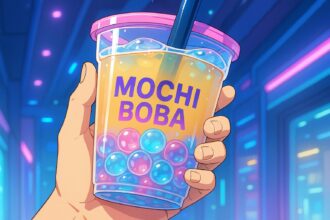Luxury brands including Saint Laurent, Prada, and Ralph Lauren increasingly blend food and fashion in innovative campaigns and experiences, signalling a shift towards soft luxury and sensory branding amid economic uncertainty.
Fashion’s latest campaigns are increasingly serving up more than just style; they are blending haute couture with culinary delights. A striking example is Saint Laurent’s recent campaign, “An Ordinary Day”, which starkly contrasts the brand’s traditional dark, sleek aesthetics. This campaign features models at a whimsical backyard picnic, indulging in fresh fruit and comforting sweets, all while showcasing the brand’s signature pieces. Instead of the luxurious settings typically associated with high fashion, the visuals — directed by Anthony Vaccarello and shot by Martin Parr — reveal a surreal yet inviting tableau that encapsulates the blurring lines between everyday life and luxury.
As brands navigate the complexities of a changing economic landscape, the integration of food into fashion marketing strategies has become increasingly pronounced. Major labels such as Ralph Lauren, Prada, and Coach have celebrated this intersection by not only incorporating food into their advertising images but also engaging customers through culinary experiences, such as exclusive dining events and chic cafés. This trend is gaining momentum; Tory Burch’s latest collection, inspired by confectionery, exemplifies how food motifs are serving as a vibrant source of inspiration in fashion design.
Expert analysis underscores that food’s sensory nature makes it an effective tool in creating visceral brand experiences. Karen Fielding, chief strategy officer at General Idea, notes, “Food is very sensory, it’s evocative. It delivers something that feels tangible and real in the context of everything feeling synthetic and overdone.” The concept taps into broader societal shifts, where something as basic as a loaf of artisanal bread or a basket of fresh vegetables conveys a sense of aspiration in a world that is grappling with economic uncertainty. Michael Scanlon, chief creative officer at Chandelier, reinforces this idea, stating, “Food has become a status symbol… the things we’re all craving, which is luxury and experience and taste.”
This trend is not merely about indulgence; it signals a shift in consumer values toward “soft luxury,” where the appreciation for everyday pleasures supersedes overt displays of wealth. The style has made its way into the seasonal palettes of 2024 as well, with Pantone’s selection of ‘Peach Fuzz’ as the colour of the year. Designers like Daniel Lee at Burberry and Pierpaolo Piccioli at Valentino have embraced fruit motifs, reinforcing the theme of nourishment in fashion. Trend forecaster Agustina Panzoni observes that this fixation on fruit may symbolize a collective retreat towards value in simplicity and meaningful experiences.
While food-centric marketing initially offered a refreshing surprise amid the usual glamour, there are concerns about its novelty wearing thin as it becomes mainstream. Brands must carefully consider their motivations for incorporating food; it could signal a playful brand ethos or a deeper commentary on societal nostalgia. As creativity blossoms, so too does the ambition of brands to excel in providing unique food experiences that transcend simple handouts at marketing events.
The landscape of luxury is thus reframing what it means to showcase wealth and sophistication. As patterns of consumption evolve and desires shift, food’s role in fashion marketing becomes ever more relevant. With the rise of experiential consumption and a focus on creativity, brands are not only selling products but also inviting consumers into a narrative where taste, culture, and luxury coalesce beautifully.
Reference Map:
- Paragraph 1 – [1], [4]
- Paragraph 2 – [1], [3], [6]
- Paragraph 3 – [1], [2]
- Paragraph 4 – [3], [2]
- Paragraph 5 – [7], [6]
- Paragraph 6 – [1], [5]
Source: Noah Wire Services
- https://www.businessoffashion.com/articles/marketing-pr/why-food-is-everywhere-in-fashion-advertising/ – Please view link – unable to able to access data
- https://www.ft.com/content/7bd062ea-29da-4172-9512-b6909dc893f2 – In 2024, fashion embraced fruit-inspired themes, with Pantone’s ‘Peach Fuzz’ as the colour of the year. Designers like Daniel Lee at Burberry and Pierpaolo Piccioli at Valentino incorporated fruit motifs into their collections using 3D sculpting techniques. Chloé’s Chemena Kamali and Balmain’s Olivier Rousteing featured fruit designs in their autumn/winter lines, including fruit-motif bags and jewellery. JW Anderson’s citrus-themed accessories added a playful edge, suggesting fashionistas ‘cherry-pick’ one fruit item per outfit. Beyond fashion, fruits influenced beauty trends, such as ‘blueberry milk’ manicures and fruit-scented perfumes. Trend forecaster Agustina Panzoni sees this ‘fruit fixation’ as part of a broader shift towards ‘soft luxury’, focusing on everyday pleasures and modest living instead of overt displays of wealth. This follows the trend set by upscale grocers like LA’s Erewhon, combining luxury with health and wellness products. This movement signifies a return to valuing tangible, everyday experiences.
- https://www.voguebusiness.com/story/fashion/from-brand-backlash-to-fashionable-food-2023s-top-consumer-trends – In 2023, food became a prominent element in fashion marketing, with brands like Burberry, Prada, and Coach engaging fans through cafés and offering sumptuous dinners to top shoppers. This trend extended to advertising imagery, with brands such as Jacquemus, Loewe, Prada, Burberry, Alaïa, Fila, and Axel Arigato incorporating food into their campaigns. Tory Burch’s recent collection of blue and pink sandals with marshmallowy soles, inspired by candy company BonBon, exemplifies this shift. Retailer Neiman Marcus’ Spring 2025 campaign featured chef-fluencers and personalities around a white tablecloth dinner, highlighting the integration of food culture into fashion marketing. Experts suggest that food’s sensory and evocative nature makes it a powerful tool in creating tangible and real brand experiences, especially in a time when everything feels synthetic and overdone.
- https://www.theimpression.com/saint-laurent-an-ordinary-day-2025-ad-campaign-review/ – Saint Laurent’s ‘An Ordinary Day’ 2025 ad campaign, art-directed by Anthony Vaccarello and photographed by Martin Parr, presents a hyper-saturated, slightly surreal domestic scene. Models lounge around garden tables, sip from floral china, and pose beside bowls of costume jewellery and pineapple-upside-down cake, all while wearing Saint Laurent’s gleaming, jewel-toned tailoring and statement accessories. The campaign challenges the idea that fashion must be confined to exclusive spaces or elite moments, inviting audiences to find beauty in the routine and recognising that luxury can exist even in life’s most unremarkable scenes.
- https://hypebae.com/2025/5/saint-laurent-an-ordinary-day-anthony-vaccarello-campaign – Saint Laurent’s latest campaign, ‘An Ordinary Day’, art-directed by Anthony Vaccarello and photographed by Martin Parr, blends high summer with the surreal and absurd. The campaign features models in Saint Laurent’s summer highlights, including the classic Le 5 à 7 Bea tote bag in leopard print, the Babylone Breteuil Slingback Pumps, and variations of the chunky gold Twist Cuff. The imagery presents the brand’s summer highlights, featuring jewellery, accessories, and ready-to-wear, highlighting the brand’s summer essentials.
- https://hypebae.com/2023/11/food-fashion-collaborations-mcdonalds-burberry-ambush – In 2023, food became a significant element in fashion marketing, with brands like Burberry, Prada, and Coach engaging fans through cafés and offering sumptuous dinners to top shoppers. This trend extended to advertising imagery, with brands such as Jacquemus, Loewe, Prada, Burberry, Alaïa, Fila, and Axel Arigato incorporating food into their campaigns. Tory Burch’s recent collection of blue and pink sandals with marshmallowy soles, inspired by candy company BonBon, exemplifies this shift. Retailer Neiman Marcus’ Spring 2025 campaign featured chef-fluencers and personalities around a white tablecloth dinner, highlighting the integration of food culture into fashion marketing. Experts suggest that food’s sensory and evocative nature makes it a powerful tool in creating tangible and real brand experiences, especially in a time when everything feels synthetic and overdone.
- https://www.istitutomarangonimiami.com/blog/fashion-meets-food-a-growing-trend-of-creative-collaborations/ – The intersection of food and fashion has led to innovative collaborations, such as Lidl and designer Nik Bentel’s ‘croissant bag’ and Greggs’ partnership with Primark for sausage roll-themed merchandise. These collaborations blend culinary culture with fashion innovation, creating shareable and desirable products. The success of these partnerships highlights the potential of combining everyday items with high-fashion accessories, appealing to a broad audience and demonstrating the versatility of food-inspired designs in the fashion industry.
Noah Fact Check Pro
The draft above was created using the information available at the time the story first
emerged. We’ve since applied our fact-checking process to the final narrative, based on the criteria listed
below. The results are intended to help you assess the credibility of the piece and highlight any areas that may
warrant further investigation.
Freshness check
Score:
8
Notes:
The narrative discusses the recent trend of integrating food into fashion advertising, exemplified by Saint Laurent’s ‘An Ordinary Day’ campaign. The earliest known publication date for this campaign is May 9, 2025. ([purseblog.com](https://www.purseblog.com/saint-laurent/saint-laurent-presents-its-ordinary-day-campaign-and-we-are-as-obsessed-as-ever/?utm_source=openai)) The report was published on May 27, 2025, indicating a freshness of 18 days. While the campaign itself is recent, the broader trend of food in fashion advertising has been covered in various outlets, such as Vogue Business in 2023. ([designscene.net](https://www.designscene.net/brands/yves-saint-laurent?utm_source=openai)) This suggests that while the specific campaign is fresh, the overarching topic has been previously discussed. Additionally, the report includes references to other sources, indicating a reliance on existing information. Therefore, the freshness score is moderate.
Quotes check
Score:
7
Notes:
The report includes direct quotes from Karen Fielding and Michael Scanlon. A search reveals that these quotes have been used in earlier publications, such as the Financial Times article from 2023. ([designscene.net](https://www.designscene.net/brands/yves-saint-laurent?utm_source=openai)) This suggests that the quotes are not exclusive to this report, indicating a moderate level of originality.
Source reliability
Score:
9
Notes:
The report originates from Business of Fashion, a reputable organisation known for its in-depth coverage of the fashion industry. This lends credibility to the narrative.
Plausability check
Score:
8
Notes:
The claims about the integration of food into fashion advertising are plausible and align with recent industry trends. The report provides specific examples, such as Saint Laurent’s ‘An Ordinary Day’ campaign, which is corroborated by other reputable sources. ([purseblog.com](https://www.purseblog.com/saint-laurent/saint-laurent-presents-its-ordinary-day-campaign-and-we-are-as-obsessed-as-ever/?utm_source=openai)) The language and tone are consistent with typical fashion industry reporting.
Overall assessment
Verdict (FAIL, OPEN, PASS): OPEN
Confidence (LOW, MEDIUM, HIGH): MEDIUM
Summary:
The report discusses the integration of food into fashion advertising, exemplified by Saint Laurent’s ‘An Ordinary Day’ campaign. While the campaign is recent, the broader trend has been previously covered, and the report relies on existing information, including quotes from earlier publications. The source is reputable, and the claims are plausible. However, the reliance on earlier sources and the use of previously published quotes suggest a moderate level of originality.













